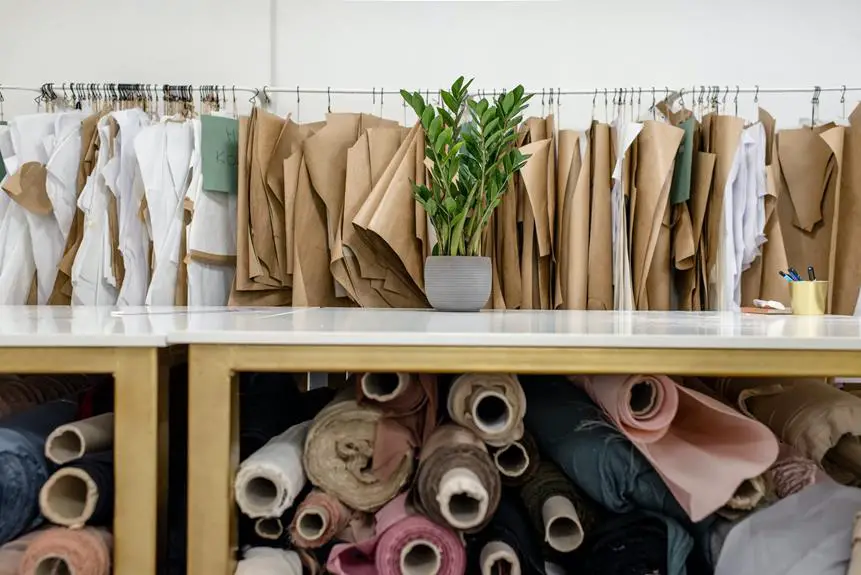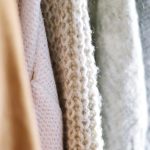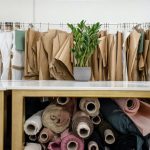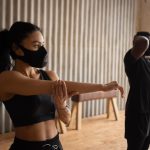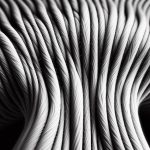Do you know that over 80% of clothing today contains Lycra fabric?
Ever wondered how this versatile and stretchy material is made?
Let's explore the fascinating process of creating Lycra fabric.
Key Takeaways
- Raw materials for Lycra fabric, such as spandex, are sourced from specialized manufacturers who adhere to sustainable practices and ethical sourcing.
- Polymer spinning is a crucial step in creating Lycra fabric, where the choice of polymer and the use of additives or blends greatly influence the fabric's characteristics.
- Fiber drawing aligns the molecules of the polymer fibers, enhancing the strength and elasticity of Lycra fabric.
- Weaving or knitting techniques determine the final characteristics of Lycra fabric, with weaving creating a sturdy and stretchy fabric and knitting techniques interlocking fibers in connected loops.
Raw Material Sourcing
When making Lycra fabric, you start by sourcing raw materials from specialized manufacturers. Sustainable sourcing and ethical practices are essential in this initial stage. It's crucial to ensure that the raw materials, such as spandex, are sourced from suppliers who adhere to sustainable practices, minimizing environmental impact and promoting fair labor conditions. Ethical sourcing also involves considering the welfare of the workers and the communities where the raw materials are produced. By prioritizing sustainable and ethical practices, the entire supply chain becomes more responsible and accountable.
Specialized manufacturers play a key role in providing the high-quality raw materials needed for Lycra fabric production. These manufacturers are selected based on their commitment to sustainability and ethical standards. This ensures that the raw materials used in Lycra fabric not only meet the highest quality standards but also align with the values of responsible and ethical production. By partnering with such manufacturers, the production of Lycra fabric upholds integrity and promotes environmentally friendly and socially responsible practices throughout the supply chain.
Polymer Spinning
To create Lycra fabric, you start by spinning polymer fibers into a stretchable and resilient material. The process of polymer spinning is crucial in determining the properties of the final fabric. Here's a breakdown of the key aspects involved:
- Polymer Properties
- Polymer Selection: The choice of polymer greatly influences the fabric's characteristics. Different polymers, such as polyurethane or polyester, offer varying degrees of elasticity and strength.
- Additives and Blends: Incorporating additives or blending different polymers can further enhance the fabric's properties, such as improving durability or increasing stretchiness.
- Spinning Techniques
- Wet Spinning: This technique involves dissolving the polymer in a solvent and extruding it into a coagulating bath. The resulting fibers have excellent strength and elasticity.
- Dry Spinning: In this method, the polymer is dissolved in a solvent and then spun into fibers through a spinneret. The fibers are solidified by evaporating the solvent, yielding fibers with specific properties.
Understanding the interplay between polymer properties and spinning techniques is essential in creating Lycra fabric with the desired stretch and resilience.
Fiber Drawing
In the process of making Lycra fabric, carefully pulling the polymer fibers through a series of draw plates results in aligning the molecules and enhancing the strength and elasticity of the material. Fiber drawing is a crucial step in the production of Lycra fabric, as it significantly impacts the quality and performance of the final product. During this process, the polymer fibers are drawn to achieve the desired level of thickness, strength, and elasticity, which are essential properties for Lycra fabric.
To better understand the significance of fiber drawing in Lycra fabric production, let's explore the key aspects involved in this stage:
| Key Aspect | Description |
|---|---|
| Yarn Production | Drawing the polymer fibers into yarns that are strong, uniform, and possess the desired stretch characteristics. |
| Aligning Molecules | Orienting the molecules along the length of the fiber, enhancing the fabric's elasticity and recovery properties. |
| Fabric Construction | Preparing the yarns for weaving or knitting processes to create Lycra fabric with the desired texture and stretch. |
Understanding the intricacies of fiber drawing is essential for mastering the production of Lycra fabric, as it directly influences the quality and performance of the final textile.
Fabric Weaving or Knitting
Once the polymer fibers have been drawn and prepared, you can weave or knit them to create Lycra fabric with the desired texture and stretch.
The weaving process involves interlacing the Lycra fibers at right angles to create a sturdy and stretchy fabric. This can be done on a variety of looms, including dobby looms for more complex patterns or jacquard looms for intricate designs. The weaving process is highly versatile, allowing for a range of fabric weights and stretch capabilities to be achieved.
On the other hand, knitting techniques involve interlocking the Lycra fibers in a series of connected loops. Circular knitting machines are commonly used for creating seamless Lycra fabric, while flat knitting machines are employed for producing panels that are later sewn together. Knitting techniques offer flexibility in creating different textures and patterns, allowing for the production of stretchy ribbed fabrics or intricate lace-like designs.
Both the weaving process and knitting techniques are crucial in determining the final characteristics of Lycra fabric, such as its stretch, texture, and overall performance in various applications.
Dyeing and Finishing
You frequently dye and finish the Lycra fabric after weaving or knitting to enhance its appearance and performance.
Dyeing techniques play a crucial role in achieving the desired color vibrancy and consistency in Lycra fabrics. The most common methods include piece dyeing, where the fabric is dyed as a whole, and yarn dyeing, where the yarn is dyed before knitting or weaving. Piece dyeing is more cost-effective for solid colors, while yarn dyeing is preferred for intricate patterns and designs.
Additionally, finishing processes are applied to Lycra fabric to improve its hand feel, durability, and functionality. These processes may involve treatments such as heat setting, which helps the fabric retain its shape, and chemical finishes to enhance moisture-wicking properties or add a soft touch. The finishing stage is crucial in ensuring that the Lycra fabric meets the desired performance standards and can withstand the rigors of its intended use.
Quality Control and Testing
After completing the dyeing and finishing processes, it's essential to carefully assess the quality and performance of Lycra fabric through rigorous testing and quality control measures. This ensures that the fabric meets the highest standards and performs as expected in various applications.
- Quality Control Measures
- Implement strict visual inspections to detect any flaws or irregularities in the fabric, such as color inconsistencies or weaving defects.
- Use advanced testing equipment to analyze the fabric's physical properties, including its stretch, recovery, and durability, to ensure it meets the specified standards.
- Product Performance Testing
- Conduct thorough performance tests to evaluate the fabric's suitability for different uses, such as sportswear, lingerie, or medical garments.
- Subject the fabric to simulated real-world conditions to assess its resilience and longevity, ensuring it withstands frequent use and washing without compromising its quality.
Frequently Asked Questions
How Has the Production Process for Lycra Fabric Evolved Over Time?
Over time, the production process for lycra fabric has evolved due to advancements in technology and increased focus on sustainability practices. These changes have led to more efficient and environmentally friendly methods of creating this versatile material.
Are There Any Environmental or Sustainability Concerns Associated With the Production of Lycra Fabric?
When considering the production of Lycra fabric, it's essential to address the environmental impact and sustainability initiatives. Efforts to minimize waste and energy consumption are crucial for a more sustainable approach to manufacturing this material.
What Are the Most Common Applications for Lycra Fabric in the Fashion and Textile Industry?
In the fashion industry, Lycra fabric is widely used for its versatility and stretch. It's the go-to material for creating form-fitting, comfortable garments that cater to current fashion trends and a wide range of textile applications.
How Does the Cost of Producing Lycra Fabric Compare to Other Types of Stretch Fabrics?
When comparing the cost of producing Lycra fabric to other stretch fabrics, market demand plays a significant role. Lycra's unique properties and versatility often make it a preferred choice, impacting the overall cost.
What Are the Potential Future Developments or Innovations in Lycra Fabric Production?
In the future, technological advancements could revolutionize lycra fabric production, leading to innovations like sustainable manufacturing processes and enhanced performance characteristics. These developments will likely shape the future of the industry.
- How Does Ring Spun Cotton Affect Garment Fit and Shape Retention? - August 13, 2024
- What Are the Challenges in Producing Ring Spun Cotton? - August 13, 2024
- Is Ring Spun Cotton Suitable for Plus-Size Clothing? - August 13, 2024

